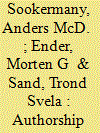| Srl | Item |
| 1 |
ID:
153622


|
|
|
|
|
| Summary/Abstract |
Armed Forces & Society (AF&S) was founded in 1974 with the overall intention of creating an international arena for interdisciplinary approaches to the study of the military institution and the intersection of armed forces and their society. The present study is both a follow-up and an update of Morten Enders’s article “Authorship and Affiliation in Armed Forces & Society” covering 1,139 articles in the 41 volumes published from 1974 until 2015. The scope has been to look for the evolving trends on Authorship and Affiliation (A&A) within AF&S so as to say something about what AF&S has become over these years, as a consequence of whom the authors are and where they come from. Our findings suggest a developmental narrative of A&A in AF&S of a continuously higher author–article ratio, an increased female authorship ratio, and a wider range of disciplines from more continents, countries, and institutions, plus a trend of increased cross-national coauthorship.
|
|
|
|
|
|
|
|
|
|
|
|
|
|
|
|
| 2 |
ID:
161537


|
|
|
|
|
| Summary/Abstract |
This Armed Forces & Society forum concentrates on broadening the perspective on military cohesion. This introduction, and the five articles that it acts as a preamble to, argues for the need to widen the scope of the recent debate on military cohesion, which in part took place in this very journal. This debate narrowly focused on Western state militaries during the 20th and 21st centuries and even then on the microlevel. The articles in this issue contribute to this broadening by exploring military cohesion in non-Western or nonmodern contexts, as well as through new methods, thus individually and collectively suggesting new ways forward to further our understanding of military cohesion.
|
|
|
|
|
|
|
|
|
|
|
|
|
|
|
|